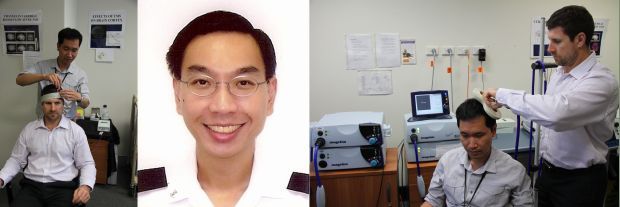
From left to right, Angelo Alonzo demonstrating transcranial direct current stimulation (tDCS), Phern Chern Tor, and a demonstration of transcranial magnetic stimulation (TMS) with Angelo Alonzo seated
Electroconvulsive therapy or ECT is one form of electrical stimulation to the brain used to treat depression. Patients given ECT are usually given an anaesthetic and muscle relaxant, but at the Black Dog Institute in Sydney, two other types of brain stimulation are being trialled for depression, both of which are conducted while the patient is awake.
Ruth Beran meets Phern Chern Tor who demonstrates transcranial magnetic stimulation (TMS) and Angelo Alonzo from the University of New South Wales who shows her a transcranial direct current stimulation (tDCS) machine. While both machines transmit an electrical pulse to the front part of the brain, there are differences between the two. TMS causes brain cells to depolarise, while tDCS increases the firing of cells by themselves. Both machines are being used in a research setting, to determine things like: how often treatment should be delivered and over what time period. While results are still coming in for the tDCS trial, previous trials have shown that two thirds of the patients who receive TMS would come back for further treatment.

